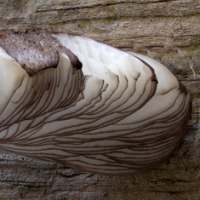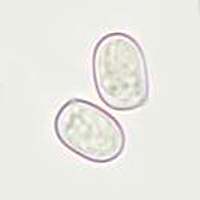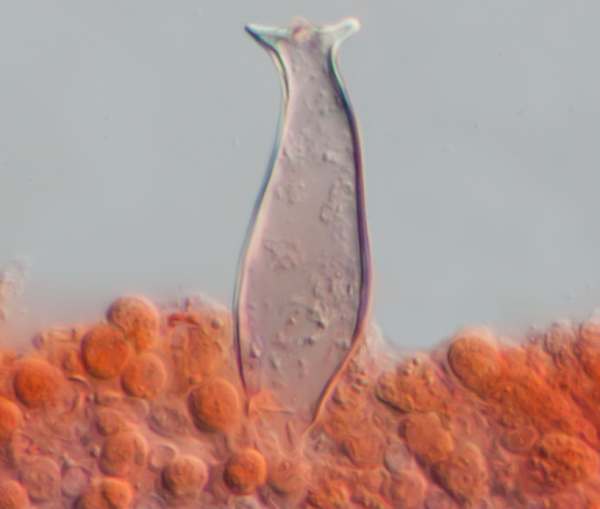Pluteus atromarginatus (Singer) Kuhner - Blackedged Shield
Phylum: Basidiomycota - Class: Agaricomycetes - Order: Agaricales - Family: Pluteaceae
Distribution - Taxonomic History - Etymology - Identification - Culinary Notes - Reference Sources
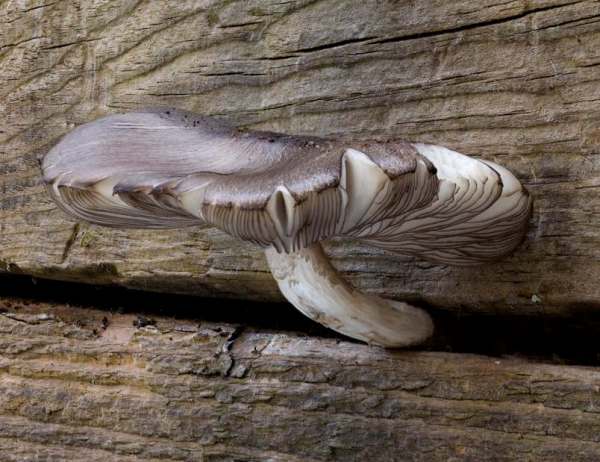
The dark cap and black-edged pale gills are striking features of this wood-rotting mushroom, which is mainly found on decaying timber from pine trees. The specimen shown above is emerging from the gap between two old railway sleepers.
Distribution
A very rare find in Britain and Ireland, this saprophytic mushroom is also recorded in many parts of northern and central mainland Europe as well as in North America.
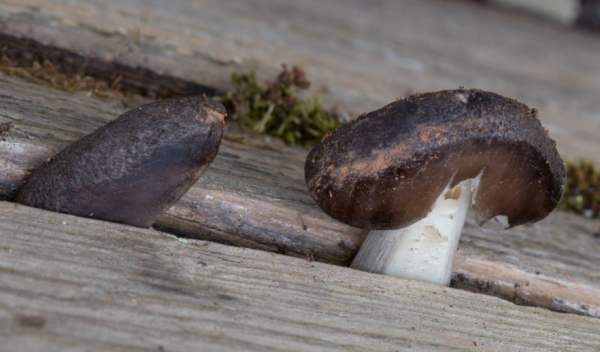
Taxonomic history
This distinctive woodland mushroom was described in 1925 by German-born American mycologist Rolf Singer, who gave it the scientific name Pluteus cervinus var. atromarginatus. French mycologist Robert Kuhner (1903 - 1996) raised its status to species level in 1935, thereby establishing its scientific name as Pluteus atromarginatus.
Synonyms of Pluteus atromarginatus include Pluteus cervinus var. nigrofloccosus R. Schulz, Pluteus cervinus subsp. atromarginatus (Singer) Kühner, Pluteus tricuspidatus Velen., and Pluteus nigrofloccosus (R. Schulz) J. Favre.
Etymology
Pluteus, the genus name, comes from Latin and literally means a protective fence or screen - a shield for example! The specific epithet atromarginatus means 'with a black edge or margin' - a reference to the dark edge of the gills.
Identification guide
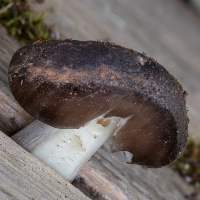 |
Cap4 to 7cm across; initially convex, developing a slight umbo while flattening; margin remaining downcurved; dark brown to almost black, with adpressed radial fibrils; centre sometimes finely scaly. |
GillsFree; crowded; white with black or dark brown edges; gill faces turning pink as the spores mature. Stem5 to 12 cm long and 0.5 to 1cm diameter, often with a slightly swollen base; smooth white surface, sometimes with dark brown or black longitudinal fibres; no stem ring. |
|
SporesBroadly ellipsoidal or subspherical, smooth, 6-8 x 4-5µm. Spore printPink.
|
|
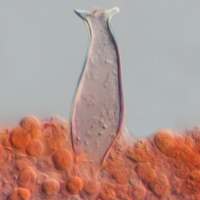 |
PleurocystidiaPLeurocystidia on the gill faces are lageniform, typically 80 x 20µm, and project well beyond the basidia; as they mature they become ornamented with two, three or sometimes four apical 'horns'.
|
Odour/taste |
Not distinctive. |
Habitat & Ecological role |
In common with other shield mushrooms, this is a wood-rotting (saprobic) fungus, but this species is unusual in being restricted to softwoods (timber of coniferous trees). Blackedge Shields tend to be either solitary or at best occuring in very small groups. |
Season |
Fruiting from early summer to late autumn. |
Similar species |
Pluteus cervinus has a smooth, paler brown or fawn cap and lacks the dark edge to its gills. |
Culinary Notes
The Blackedge Shield is reported to be an edible mushroom, but in view of its rarity this mushroom should not be gathered for eating.
Reference Sources
Fascinated by Fungi, 2nd Edition, Pat O'Reilly 2016, reprinted by Coch-y-bonddu Books in 2022.
Singer, R. (1956). Contributions Towards a Monograph of the Genus Pluteus. Trans. Br. Mycol. Soc. 39(2): 145-232.
Orton, P.D. (1986). British Fungus Flora: Agarics and Boleti. Vol 4. Pluteaceae: Pluteus & Volvariella. Royal Botanic Garden: Edinburgh, Scotland.
Funga Nordica: 2nd edition 2012. Edited by Knudsen, H. & Vesterholt, J. ISBN 9788798396130
BMS List of English Names for Fungi
Dictionary of the Fungi; Paul M. Kirk, Paul F. Cannon, David W. Minter and J. A. Stalpers; CABI, 2008
Taxonomic history and synonym information on these pages is drawn from many sources but in particular from the British Mycological Society's GB Checklist of Fungi.
Acknowledgements
This page includes pictures kindly contributed by David Kelly.
Fascinated by Fungi. Back by popular demand, Pat O'Reilly's best-selling 450-page hardback book is available now. The latest second edition was republished with a sparkling new cover design in September 2022 by Coch-y-Bonddu Books. Full details and copies are available from the publisher's online bookshop...

